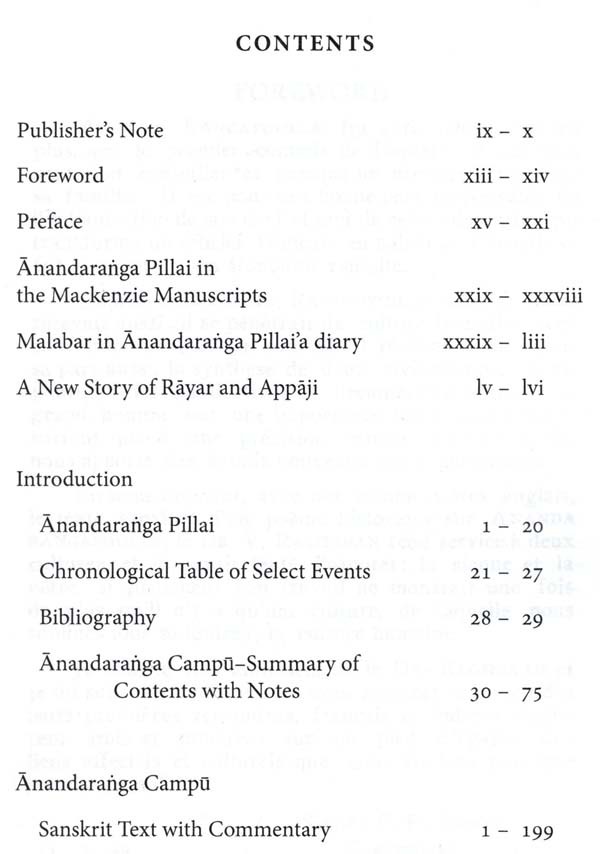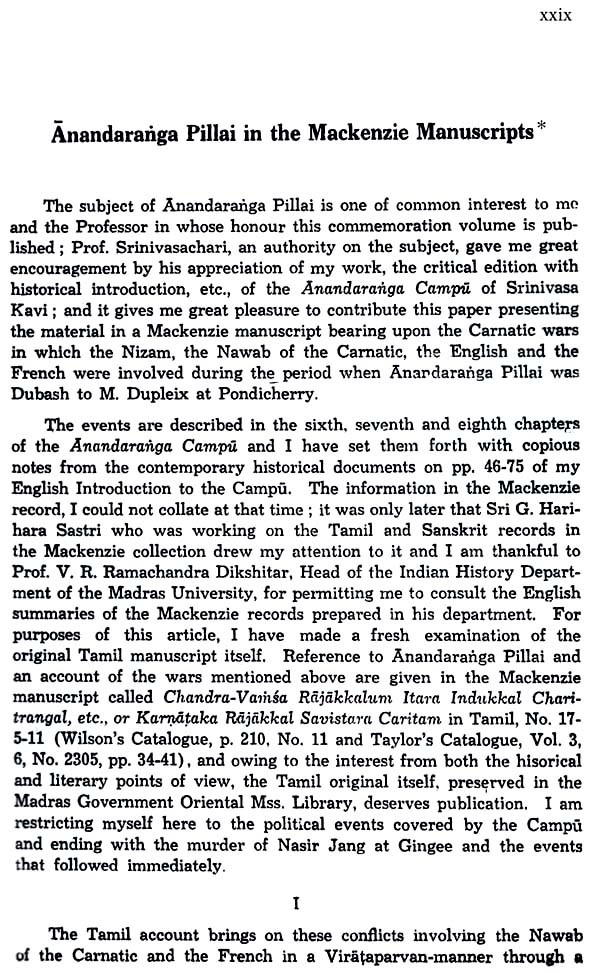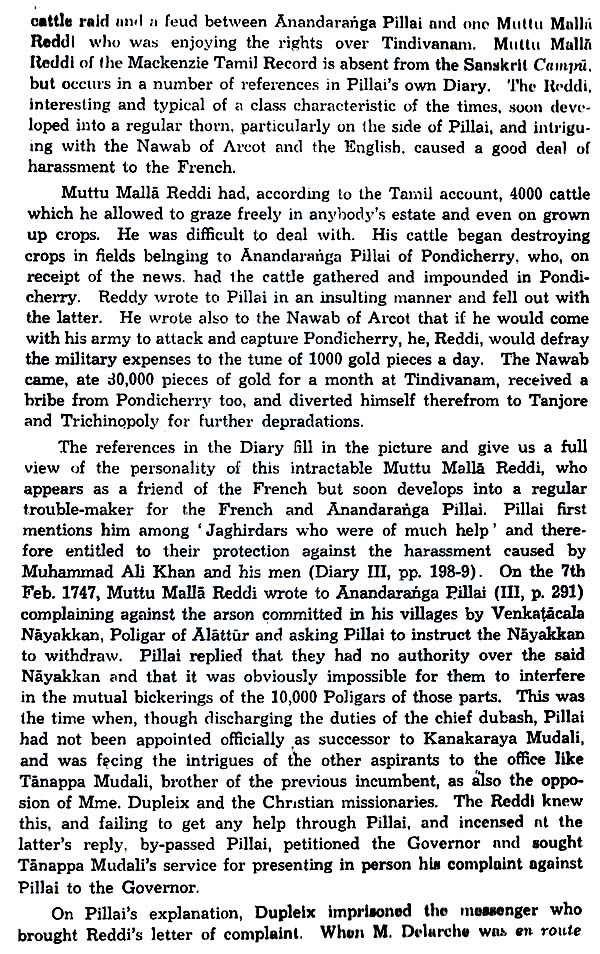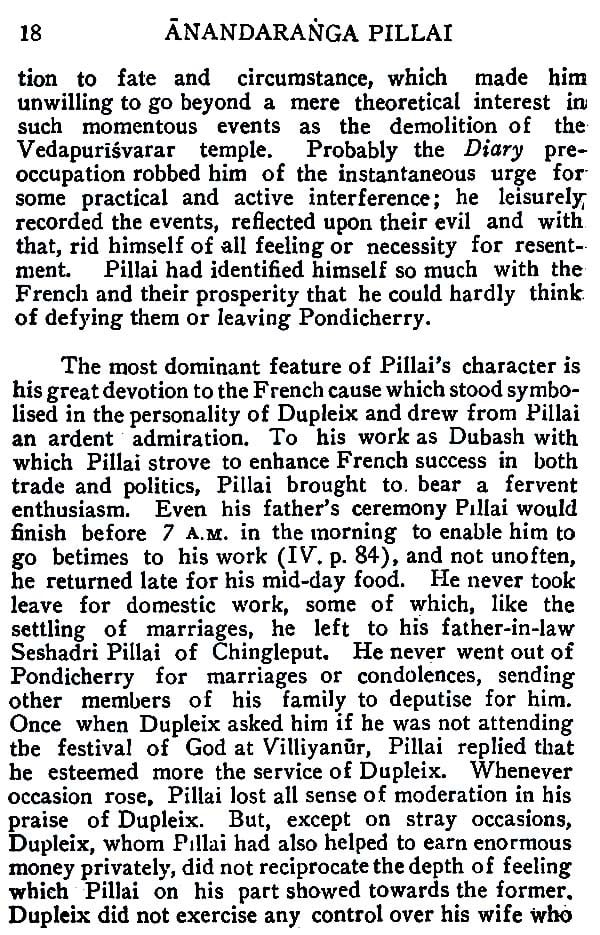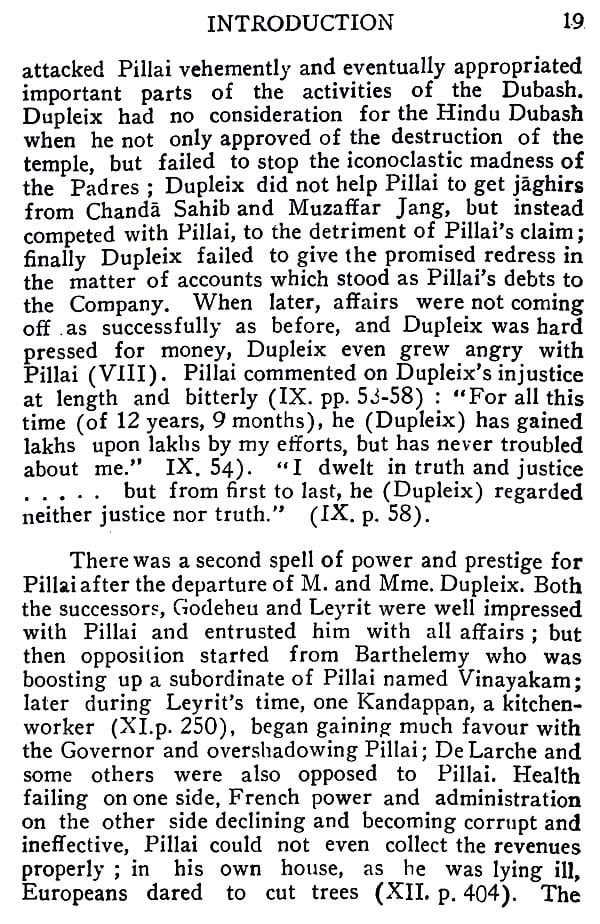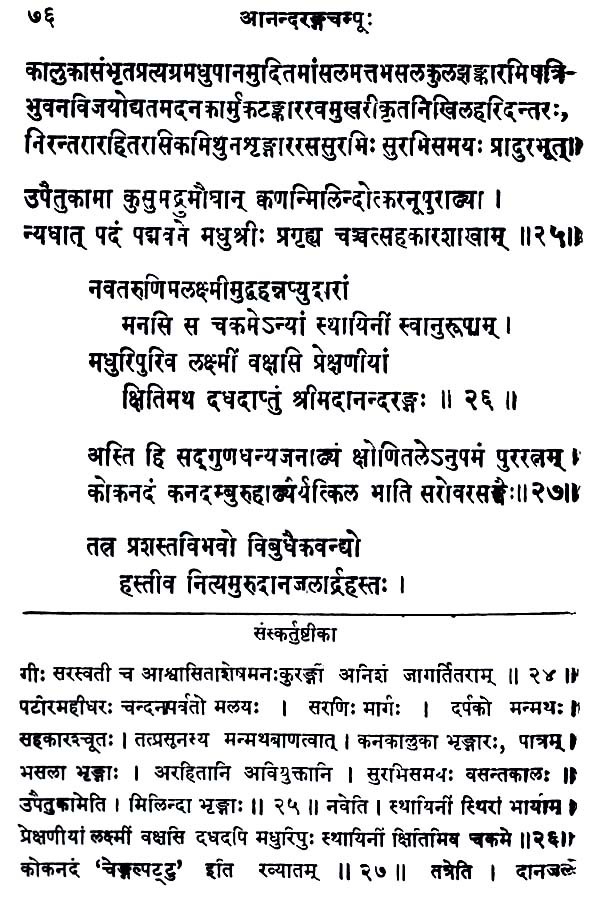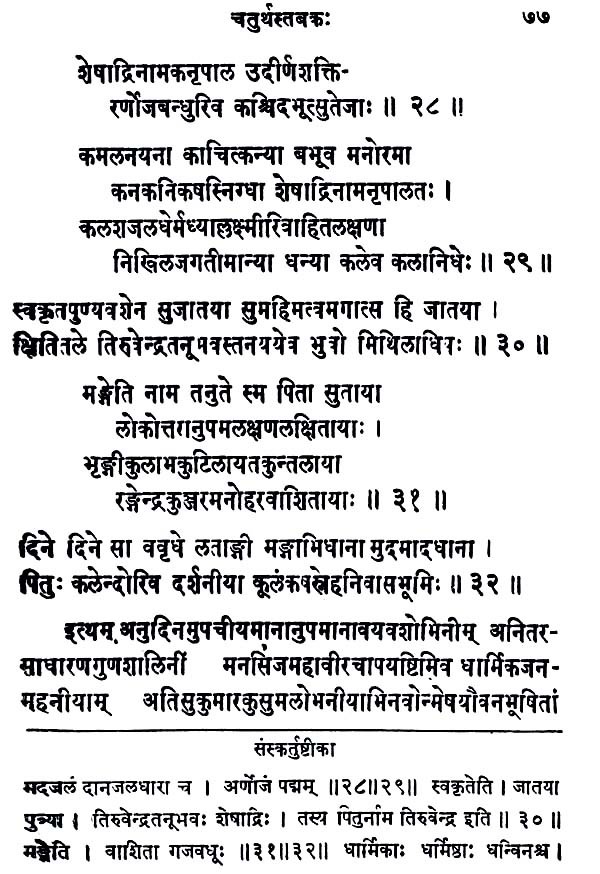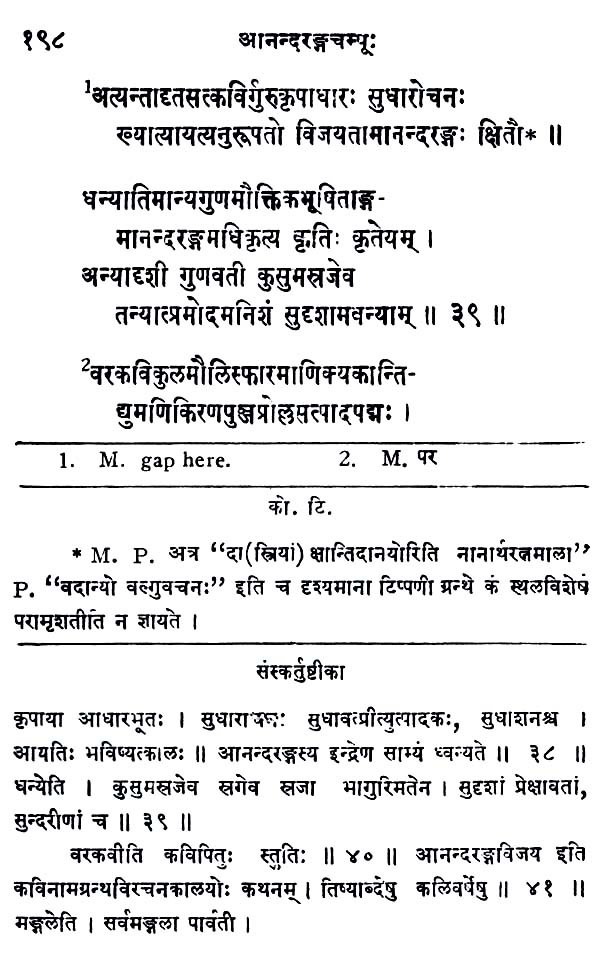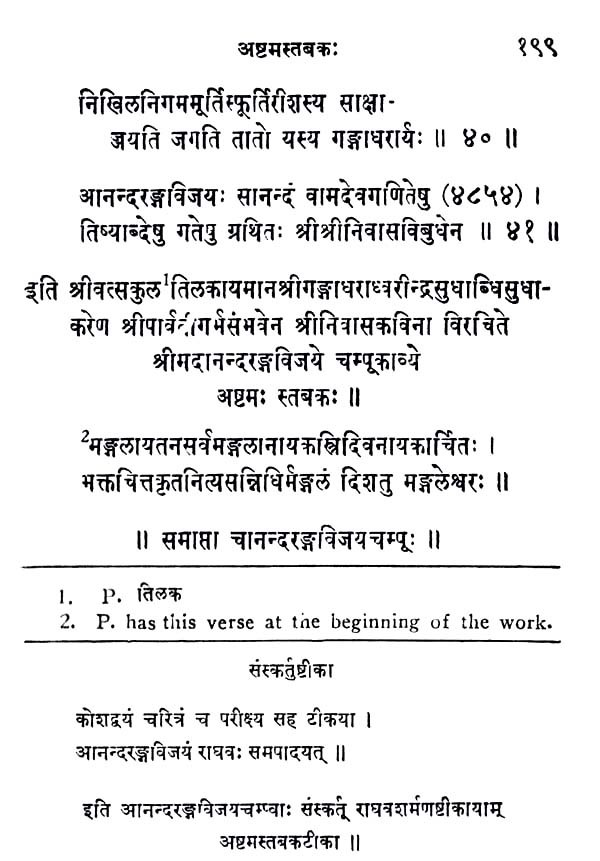
Anandaranga champu
Book Specification
| Item Code: | AZA522 |
| Author: | Dr. V. Raghavan |
| Publisher: | Dr. V. Raghavan |
| Language: | English |
| Edition: | 2021 |
| Pages: | 350 |
| Cover: | PAPERBACK |
| Other Details | 8.5 x 5.75 inches |
| Weight | 380 gm |
Book Description
The Anandarangavljaya Campu is an addition to the Historical Kavyas in Sanskrit and to the materials already available on the life of Anandaranga Pillai, Dubhash of the French at Pondicherry, and on the history of the Deccan and the Carnatic in the first half of the 18th Century. The most important of the later-mentioned materials bearing on the life and doings of Anandaranga Pillai is the Daily Diary, Dina Carnal", which he himself has left and to which voluminous and valuable document, not yet available in print in the original Tamil, the attention of the historians has been drawn by the twelve volumes of its English Translation published by the Madras Government. The Diary starts only in the 27th year of its author, 1736, and when we consider the fact that it is preoccupied with official and public affairs, a work like the present which is a direct account of the Diarist will be welcome to those who desire to know fully the history of the family and the private life of the author of the Diary. It is true that there are strewn over the pages of the Diary numerous references to private and domestic matters, but these are only casual and stray statements requiring a careful co-ordination, for purposes of making out a connected account of the private life of the Diarist? The Telugu work on Prosody, Anandarangarat Chandamu by Kavi Kasturi Rangayya patronised by Anandaranga Pillai, no doubt gives a connected account of the family and life of Anandaranga Pillai, but that furnished by the Camp] edited here is fuller and far more detailed.
The Anandaranga Campd is not less significant to the student of history ; for even on the historical side, this Camp] would be found to be a valuable sup-plement to the Diary, which, it is well known, has several gaps due to the loss of the pages in the original. Two of these gaps are at the important places where we should find the description of the battle of Ambfir and the murder of Nasir Jang; two important events in the Carnatic which have been recognised by historians as having shown the foreign trading companies the way to their political rise in this country. It is only recently that a few of the missing pages of the Diary, and among these a day's entries bearing on the murder of Nasir Jang, have been recovered and published in English Translation. On both these battles, besides other connected affairs, the Camp] is fully informative; and what is more improtant, a verification of some of the details shows that the poet is reliable in his account of these events. Besides, there is one point explaining the origin of the feud between Hidayat Muhi-ud-din Khan (Muzaffar Jang) and his uncle, the Nizam, Nasir Jang, which is known for the first time only from the Camp]. In connection with this feud, what has been recorded hitherto by historians is that during his lifetime, Asaf Jah had shown much partiality to his daughter's son and governor of Bijaput and Adoni, Hidayat Muhi-ud-din Khan,. which had led to the belief that perhaps Asaf Jib had thought of this grandson as his successor in the Deccan. The Camp] for the first time mentions that Hidayat Muhi-ud-din's father had been murdered by Nish Jang, the brother-in-law. Of this father of Hidayat Muhi-ud-din and son-in-law of Asaf Jah, source books like the Diary of Anandaranga (as available now) make no mention. Of modern books on the period, the only book to speak of this son-in-law of Asaf Jilt is The Nizam by Briggs. Briggs says that this son in-law was named Mutuwussil Khan, that he was in charge of the fort of Molheir, that when Asaf Jab was opposed in battle by his rebellious son Nisir Jang near Aurangabad, Mutuwussil Khan was about to kill his brother-in-law Nasir Jung, but that the young son of Muthuwussil Khan, Hidayat Muhi-ud-din, interceded and saved his uncle Nasir fang? Even Briggs could not command any materials which took him further than this. The Camph fills the picture when it says that Nasir Jang (subsquently) murdered his brother-in-law Mutuwussil Khan, which must have given sufficient motive power to his young nephew and previous saviour, Hicayat-Muhi-ud-din, to rise in rebellion against his uncle and contest the throne of the Nizam.
Another noteworthy point in the Campo is the light it throws on the origin of the name Cennapattana by which Madras is known. The Campo gives the name in its full form as Cennakeiavapura on two occasions, when Anandaranga's father Tiruvengafa Pillai returned to Madras as a result of the persecution of his brother-in-law by M. Hebert at Pondicherry and when shortly after, M. de la Prevostere induced him to return to Pondicherry with a large body of Madras
ANANDA RANGAPOULLE fut autre chose, et bien plus, que le premier commis de Dupleix : it fut. souvent son conseiller •et presque on membre adoptif de sa famine. 11 est pour une bonne part responsable de l'indianisation de son chef et ami de cette adaptation qui transforma un officier francais en nabab du Carnatic et fut le secret de son etontiante reussite.
Aupres de DUPLEX; RANGAPOULLE donnait, mais recevaiy aussi: it or penetrait de culture francaise tout en restant un ecrivain tamoul. Il realisait done, pour sa part aussi, la synthese de deux civilisations. C'est pourquoi les publications de decuments inedits our ce grand homme ont une importance toute particuliere; surtout quand une precision, comme c'est ici le cas, nous apporte des details nouveaux sur le personnage.
En nous dormant, avec des commentaires anglais, it texte sanskrit d'un peeme historique sue ANANDA RANGAPOULLE, le DR. V. RAGHAVAN rend service I deux cultures, et je serais tente d'ajouter : la sienne et la nOtre, si justement son travail ne montrait une fois de plus qu'il n'y a qu'une culture, de laquelle nous sommes tour smidaires; la culture humaine.
Je fellcite tres amitalement le DR. RAGHAVAN et je lui suis reconnaissant de nous montrer commentdes leurs premieres rencontres, francais et indiens devin-rent amis et noubrent sur un pied d'egalite des. liens affectifs et culturels que nous voulons plus que jamais consolider.
**Contents and Sample Pages**
